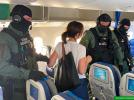UPS A306 at Birmingham on Aug 14th 2013, contacted trees and touched down outside airport
A UPS Airbus A300-600, registration N155UP performing freight flight 5X-1354 from Louisville,KY to Birmingham,AL (USA) with 2 crew, was on approach to Birmingham's runway 18 at 04:51L (09:51Z) but touched down near the intersection Airport Road/Tarrant Huffman Road about 0.8nm short of the runway in open terrain, burst into flames leaving a trail of debris of about quarter of a nautical mile and coming to a stop about 0.55nm before the runway threshold and slightly left of the extended center line. Both crew were killed. The area has been cordoned off. No people on the ground or houses on the ground were affected.
Local police reported a large cargo aircraft crashed just outside the airport and said - following the Mayor's announcement of both crew having died - that both crew are still unaccounted for.
The FAA confirmed a UPS cargo aircraft crashed at Birmingham Airport. The FAA later declined comments on the condition of the crew (following Birmingham City Mayor's announcements the crew had perished in the crash), but in the afternoon (local time) confirmed both flight crew were fatally injured in the crash.
Birmingham Shuttlesworth International Airport reported a UPS Cargo Airbus A300 went down just outside the airport perimeter fence, so far there is no word on the fate of the crew and damage to the aircraft (repeated after the City Mayor made his announcements).
The Mayor of Birmingham said, that both crew perished in the crash.
UPS confirmed on Twitter one of their aircraft was involved in an incident at Birmingham,AL Airport. The airline has no verified information on the condition of their crew.
Airbus confirmed N155UP suffered an accident shortly after 09:50Z while on approach to Birmingham,AL arriving as flight 5X-1354 from Louisville,KY. The aircraft was produced in 2003 and had accumulated roughly 11,000 flight hours in 6,800 flight cycles. A team of Airbus specialists have been dispatched to Alabama to join the investigation by the NTSB, members of the French BEA are also going to join the investigation.
The NTSB have dispatched a go-team of 26 investigators to Birmingham,AL. An on site press conference has been scheduled at 16:00L (21:00Z).
In their first press conference on Aug 14th 2013 the NTSB reported the A300-600F N155UP flight 5X-1354 crashed while on approach to runway 18 of Birmingham. There were three impact points prior to the final position of the wreckage over a distance of about 200 yards (200 meters). It appears the aircraft contacted a number of trees on the top of the hill prior to the first point of impact on the ground. The overwing section was extensively damaged by fire, the tail section was still smouldering preventing the black boxes to be recovered, the NTSB is optimistic to recover the boxes the next day. The investigation will "begin in earnest tomorrow morning". Initial information, subject to verification, suggests the crew did not issue a distress call.
In their second press conference on Aug 15th the NTSB reported the black boxes were recovered at about 11:00L after 3 hours of work, the boxes were blackened and sooted, the NTSB however is optimistic to retrieve good data from the boxes. The boxes are being shipped to Washington for analysis where they should arrive in the evening. It should be known on Friday (Aug 16th) whether there are good data on the boxes. Preliminary information shows no evidence of an engine's uncontained failure or fire prior to impact, there is also no evidence of a pre-impact ingestion of foreign objects. The radar data have been obtained. There are no indications of failure of runway/approach lighting, subject to verification. Runway 06/24 was closed at the time of the accident for maintenance of runway center line lights.
In their third press briefing on Aug 16th 2013 the NTSB said, the "recorders did their job", there are good data, the cockpit voice recorder as well as the flight data recorder hold the entire flight. The captain (ATPL, 8,600 hours total, 3,200 hours on type) was pilot flying, the first officer (ATPL, 6,500 hours total, 400 hours on type) was pilot monitoring, the crew briefed the LOC approach runway 18, 2 minutes prior to the end of recording the aircraft received landing clearance on runway 18, 16 seconds before end of recordings there are two audible alerts by the GPWS "Sink Rate! Sink Rate!", 13 seconds prior to end of recording one crew member said "runway in sight", 9 seconds prior to end of recording sounds consistent with impact occurred. The flight data recorder contains more than 400 parameters requiring verification that these parameters are valid, this process takes time. It holds 70 hours of data including the entire accident flight. There were two controllers on duty at Birmingham tower, one controller was taking a break as permitted. The remaining controller observed the crash, he saw sparks and a large bright orange flash that he interpreted as breaking of a power line, he saw the landing lights, then no longer saw the landing lights and instead saw a large orange glow, he activated the crash button. There were no alerts regarding minimum safe altitude issued by his radar system. The crew started their "duty day" in Rockford,IL at 9:30pm on Aug 13th and flew to Peoria,IL as flight 5X-617 on A306 N161UP, then to Louisville,KY again as flight 5X-617 on N161UP before departing for the accident flight 5X-1354 on N155UP.
In their fourth and last press conference on Aug 17th the NTSB reported, the flight data recorder data have been validated. First results suggests the flight control inputs and flight control surface movements correlate, the engine parameters were normal. The flight data recorder stopped a few seconds prior to the cockpit voice recorder. The autopilot was engaged until the end of flight data recording end, the speed was about 140 KIAS as selected by the autoflight system consistent with the expected approach speed. The flight data recorder also confirmed the Sinkrate GPWS alerts. A checkflight by FAA on the PAPI system confirmed the PAPIs were indicating correctly to 1/100th of a degree. The aircraft had been updated to comply with all service bulletins and airworthiness directives.
On Feb 20th 2014 the NTSB released a number of documents into their public docket as part of the scheduled public hearing into the crash. The factual report submitted by the investigators states, that the aircraft performed a LOC 18 approach to Birmingham following an eventless flight with the crew, according to testimonies by ground personnel at Louisville in good/normal mood, intercepting the localizer at 2500 feet MSL. After crossing BASKN at 2500 feet the aircraft began the descent, the rate of descent increased to 1500 fpm and the aircraft descended through the decision altitude (1200 feet MSL, 556 feet AGL) at 1500 feet per minute rate of descent. An aural "sink rate" alert was raised by the EGPWS at 235 feet AGL (1536 fpm), 7 seconds after the sink rate the aircraft contacted tree tops and terrain about 1.2nm short of the runway threshold, portions of the aircraft came to rest about 0.75nm from the runway threshold. The captain (58, ATPL, 6,406 hours total, 3,265 hours on type) was pilot flying, the first officer (37, ATPL, 4,721 hours total, 403 hours on type) was pilot monitoring. The factual report also stated, that the charts used by the crew still showed the remark "When VGSI inop, procedure NA (not authorized) at night" that had been cancelled and revoked by the FAA in December 2011. The charts were only updated following the crash. The flight data recorder showed the aircraft was on autopilot maintaining 2500 feet while intercepting the localizer, the autopilot captured the localizer successfully and subsequently tracked the localizer until end of recording. A vertical speed of -700 fpm was selected into the master control panel, the aircraft began to descend below 2500 feet MSL consistent with intercepting the glidepath, 26 seconds after the begin of the descent the vertical rate was increased to 1500 fpm in the master control panel followed by the change of target altitude from 2500 feet to 3775 feet MSL. 45 seconds after the vertical speed was increased to -1500 fpm the EGPWS sounded "Sink Rate", an immediate response reduced the rate of descent to about -500 fpm. The control column position began to move towards nose up commands, 8 seconds after the EGPWS warning the autopilot disconnected (not stated whether disconnected by pilot command or automatically disconnected), an autopilot disconnect aural warning occurred, the autothrottle changed from speed to retard mode and the recording ended showing 7 degrees nose up and 138 KIAS at 14 feet AGL at last recording. The factual report regarding the cockpit voice recording shows the crew believed they were kept high and were complaining just after reading the final landing checklist and decided to use vertical speed. Shortly after the missed approach altitude was selected, both crew again commented they were too high for the approach, then the first officer commented "thousand feet", instruments cross checked, no flags, the captain remarked "DA is twelve hundred", then called 2 miles, shortly after the EGPWS sounded "Sink Rate", the captain got visual with the runway, the first officer confirmed runway in sight, the captain stated "autopilot's off", the autopilot cavalry charge (disconnect) sound was recorded following by first sounds of impact within a second after the begin of the cavalry charge, the EGPWS sounded "too low Terrain", the captain asked "Did I hit something?" followed by exclamations from both crew and sounds of impact until end of recording.
Birmingham Shuttlesworth International Airport offers a Localizer Approach and a RNAV(GPS) Approach to runway 18, length 7,099 feet/2,160 meters.
NOTAMs (released AFTER the crash, no NOTAMs related to runway 18 prior to the crash):
08/036 (A0368/13) - NAV ILS RWY 18 LLZ/DME U/S. 14 AUG 11:01 2013 UNTIL UFN. CREATED: 14 AUG 11:02 2013
08/035 (A0367/13) - RWY 18/36 CLSD. WIE UNTIL UFN. CREATED: 14 AUG 10:56 2013
Metars:
KBHM 141106Z 00000KT 9SM FEW005 OVC070 23/22 A2999 RMK AO2 FEW005 FU
KBHM 141053Z 01003KT 10SM OVC070 23/22 A2999 RMK AO2 SLP146 T02330222
KBHM 140953Z 34004KT 10SM FEW011 BKN035 OVC075 23/22 A2997 RMK AO2 SLP141 T02330222
KBHM 140904Z 00000KT 10SM SCT010 BKN075 23/22 A2996 RMK AO2
KBHM 140853Z 00000KT 10SM BKN010 OVC075 23/22 A2997 RMK AO2 CIG 006V013 SLP138 T02330217 52000
KBHM 140848Z 33003KT 10SM OVC010 23/22 A2997 RMK AO2 CIG 006V013
KBHM 140753Z 00000KT 9SM OVC008 23/22 A2996 RMK AO2 CIG 007V011 SLP137 T02330217
KBHM 140734Z 00000KT 10SM BKN010 BKN016 23/22 A2996 RMK AO2
KBHM 140712Z 00000KT 9SM SCT006 BKN016 23/22 A2997
KBHM 140712Z 00000KT 9SM SCT006 BKN016 23/22 A2997 RMK AO2
KBHM 140653Z 00000KT 10SM OVC006 23/22 A2997 RMK AO2 CIG 005V009 SLP141 T02330217
KBHM 140553Z 00000KT 7SM OVC004 23/22 A2998 RMK AO2 SLP142 60002 T02330222 10250 20228 403110228 56005
The PAPI lights runway 18 in the morning of Aug 14th past the crash seen from downwind runway 24:
An NTSB investigator carries one of the two charred black boxes from the wreckage (Photo: NTSB):
Aerial view of the crash site (Photo: AP/Frank Couch):
Damage to the cockpit section (Photo: NTSB):
The front section of the aircraft (Photo: City of Birmingham/April Odom):
The remains of the aircraft (Photo: AP/Hal Yeager):
The crash site (Photo: K.A. Turner):
The crash site seen from the aircraft after daybreak (Photo: Drew Shreeve):
Map (Graphics: AVH/Google Earth):
LOC runway 18 (Graphics: FAA):
RNAV/GPS runway 18 (Graphics: FAA):
http://avherald.com/h?article=466d969f














Komentarze